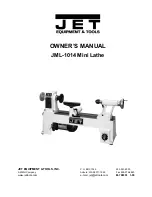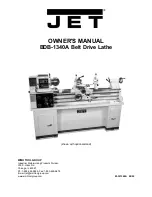
Serious injury or death can occur from getting entangled in, crushed between, or struck
by rotating parts on a lathe! Rotating workpieces can come loose and strike operator or
bystanders with deadly force if they are improperly secured, rotated too fast, or are not strong
enough for the rotational forces required for turning. Improper tool setup or usage can cause
tool kickback or grabbing, resulting in impact injury or entanglement. To reduce the risk of
operator (or bystander) injury or death, anyone operating this machine MUST completely heed
the hazards and warnings below.
WEAR PROPER PPE. Always wear a face shield
and safety glasses when operating lathe. Do not
wear gloves, necktie or loose clothing. Keep long
hair away from rotating spindle.
USE CORRECT SPEEDS. Select correct spindle
speed for workpiece size, type, shape, and
condition. Use low speeds when roughing or when
turning large, long, or non-concentric workpieces.
Allow spindle to reach full speed before turning.
AVOID TOOL KICKBACK. This occurs when
turning tool is grabbed or ejected from workpiece
with great force. Commonly caused by poor
workpiece selection/preparation, improper tool
usage, or improper machine setup or tool rest
adjustment.
SAFELY PERFORM ROUGHING. Use correct
tool. Take light cuts, use low speeds, and firmly
support tool with both hands.
USE SHARP TOOLS. Sharp tools cut with
less resistance than dull tools. Using dull tools
increases the risk of tool kickback or grabbing.
SAFELY STOPPING ROTATION. Always allow
rotating workpiece to stop on its own. Never put
hands or another object on workpiece to stop it.
SAFELY MEASURE WORKPIECE. Only mea-
sure mounted workpiece after it has completely
stopped. Trying to measure a spinning workpiece
increases entanglement risk.
SANDING/POLISHING. To reduce entanglement
risk, remove tool rest before sanding. Never
completely wrap sandpaper around workpiece.
VERIFY WORKPIECE INTEGRITY. Verify each
workpiece is free of knots, splits, nails, or foreign
material to ensure it can safely rotate on spindle
without breaking apart or causing tool kickback.
PROPERLY PREPARE WORKPIECE.
Before mounting, cut off waste portions to
balance workpiece for safe rotation and removal
of large edges that can catch on tooling.
SECURE LOCKS. Verify tool rest, headstock,
and tailstock are secure before turning lathe
ON.
SECURE WORKPIECE. Use proven setup tech-
niques and always verify workpiece (and centers/
tooling holding workpiece) are well-secured before
starting lathe. Only use high-quality fasteners with
non-tapered heads for faceplate attachment.
ADJUST TOOL SUPPORT. An improperly sup-
ported tool may be grabbed or ejected. Adjust tool
rest approximately
1
⁄
4
" away from workpiece and
1
⁄
8
" above workpiece center line to provide proper
support for turning tool. Firmly hold turning tool
with both hands against tool rest.
REMOVE ADJUSTMENT TOOLS. Remove all
chuck keys, wrenches, and adjustment tools
before turning lathe
ON. These items can become
deadly projectiles when spindle is started.
CHECK CLEARANCES. Before starting spindle,
verify workpiece has adequate clearance by
hand-rotating it through its entire range of motion.
TEST NEW SETUPS. Test each new setup by
starting spindle rotation at lowest speed and
standing to side of lathe until workpiece reaches
full speed and you can verify safe rotation.
-10-
Model T32536 (Mfd. Since 10/20)
Additional Safety for Wood Lathes
Summary of Contents for T32536
Page 44: ......





























